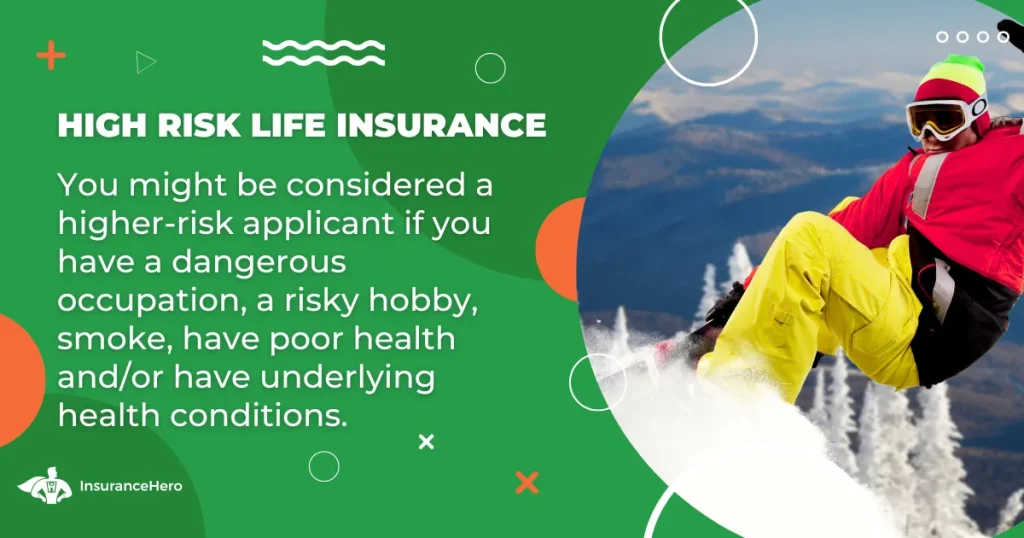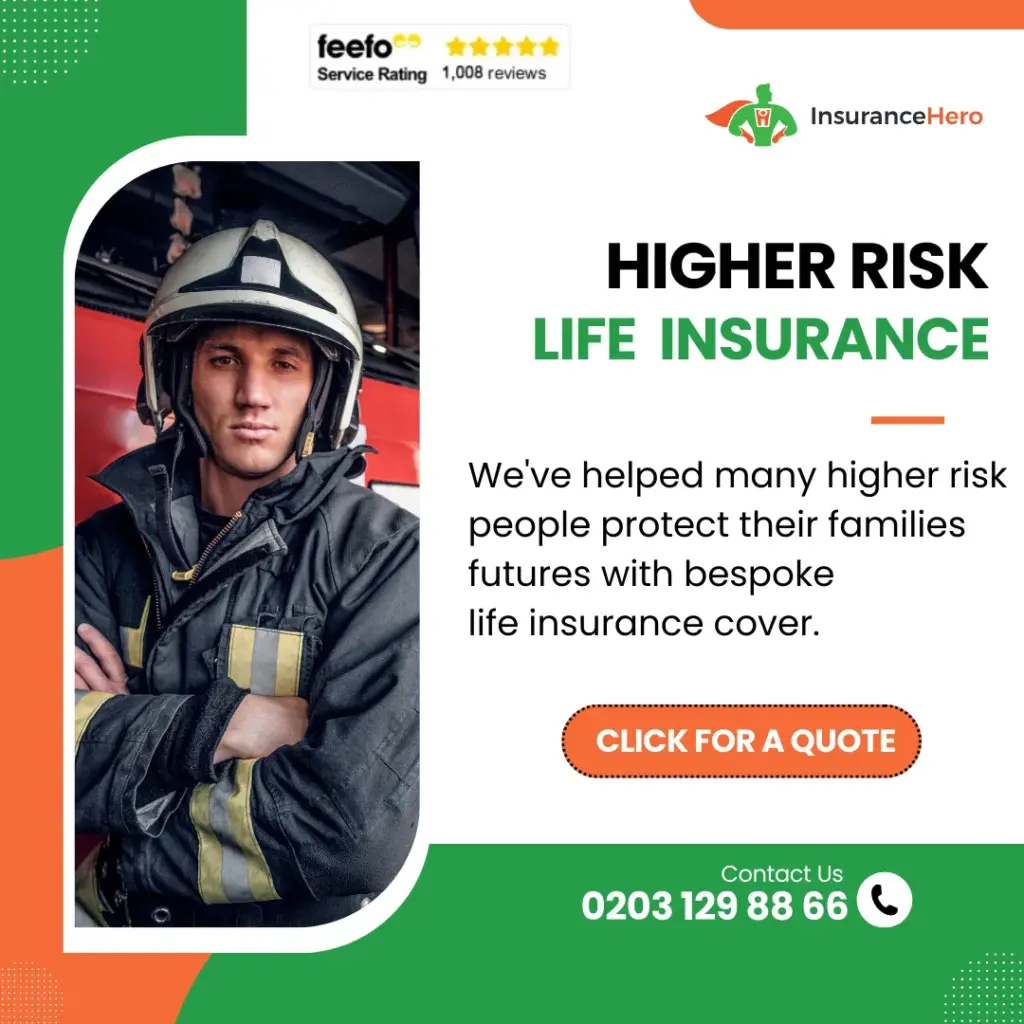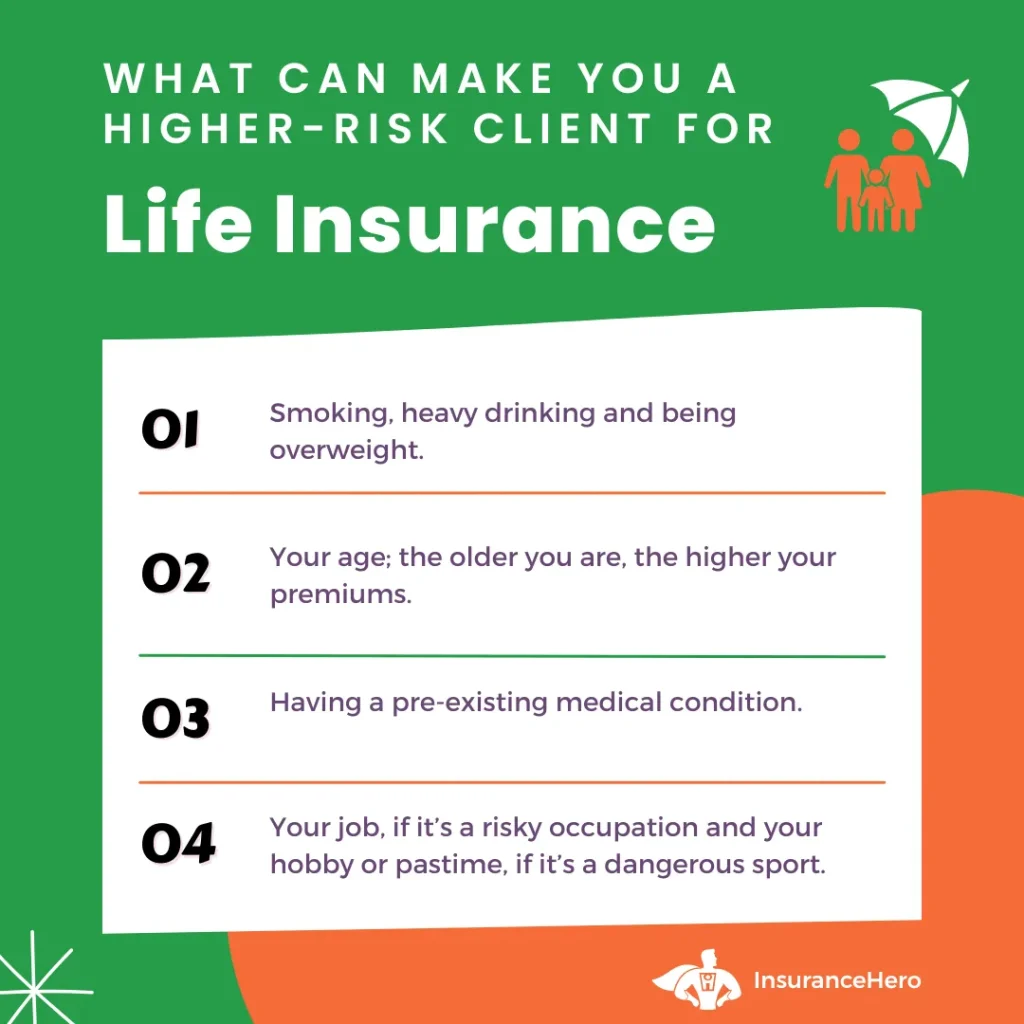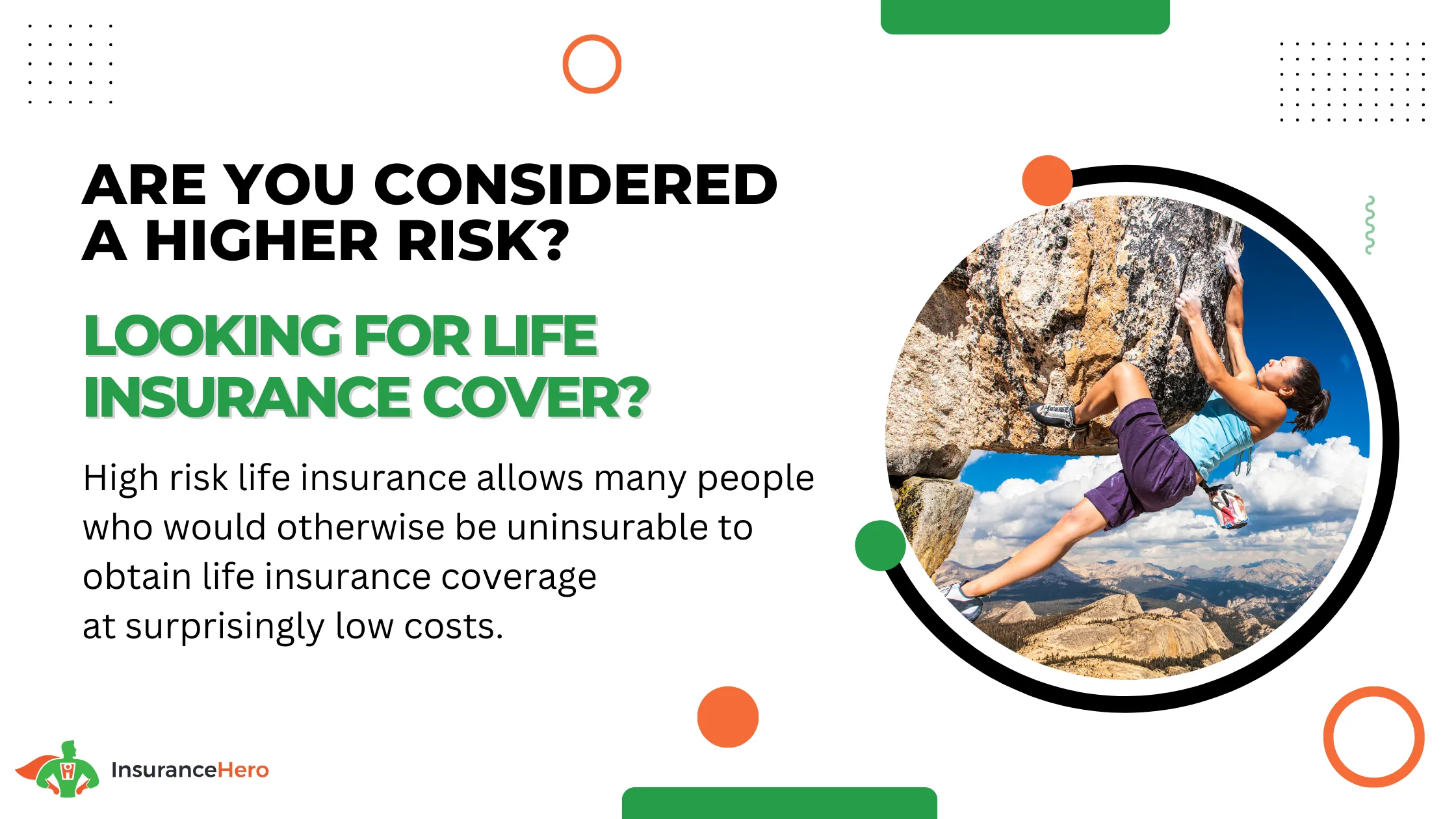High Risk Life Insurance Guide For 2026

Some claim that getting life insurance is impossible once the insurer deems you a high-risk applicant. That’s not true.
Is it possible for people considered to be a higher risk to obtain life insurance?
It is a simple yes. People classed as high risk can find life insurance options available to them.
Being classified as a higher risk by insurance providers does not necessarily result in an automatic rejection of your application.
With over 12 years of expertise, Insurance Hero specialises in assisting many people in acquiring the necessary insurance coverage at a cost-effective price.
Should you have faced rejection previously due to being labelled as high-risk, there are still numerous coverage options for you to explore.
Our dedicated team, focusing on impaired risk, is equipped to assist in securing some level of insurance coverage, even for those who have been turned down before.
Help Protect Your Family’s Future by Comparing the Top High-Risk Insurers. Finding your Cheapest Quote ⏱ Takes About 60 Seconds.


While in some instances, an insurance company can deny your life insurance claim, being “labelled” as high risk doesn’t automatically decline your claim. It can impact your insurance premiums, though.
The higher your risk of death, the higher your insurance costs will be. That is one reason some opt out of life insurance, believing their high-risk lifestyle, age, or occupation is not worth the trouble.
To determine why some people do this, we’ll examine high-risk life insurance policies. What are they, how much do they cost, and how to pick the best one?
What Is High Risk Life Insurance?
High risk life insurance is nothing more than a life insurance policy for people at greater risk of death during the insurance term. An insurer can deem you riskier when looking at your risk profile.
The risk profile is calculated based on factors such as age, lifestyle, occupation, etc. The more risk factors you have, the more likely the insurance company will have to pay out. That is why the cost of life insurance for high-risk applicants is typically higher compared to “standard-risk” life insurance policies.
As for the policy itself, it works the same way as any other life insurance coverage. If you die, the insurer will pay out the specific sum to beneficiaries, ensuring your loved ones stay protected if the worst occurs.
What Contributes to Life Insurance for High-Risk Individuals?
As said, insurers decide whether you are a high-risk applicant based on your risk profile.
If a factor(s) contributes to your increased risk of death, an insurer will include it in your profile and deem you as a higher-risk individual, which will then apply to the cost of your life insurance. Some insurers might decline your insurance claim if they decide the risk of your death is too high.
These factors include:
- Age. The older you are, the more you can expect to pay for your life insurance;
- Health. An insurer will look at your and your family’s medical history, as well as whether you have any pre-existing medical conditions;
- Lifestyle. Insurers deem smokers and people exceeding their 14-units-of-alcohol-per-week rate as high-risk individuals;
- Weight. People with high BMI are considered a higher risk due to the increased risk of developing specific medical conditions;
- Occupation. Some jobs are riskier than others. You can, for example, be a police officer, firefighter, military, etc. In essence, if you face life-threatening situations in your job, you will be considered a high-risk applicant;
- Hobbies. If you like to participate in extreme sports or dangerous hobbies, these can lead to insurers deeming you a high-risk individual;
- Travel. Your level of risk will also depend on you travelling to countries considered as dangerous (e.g., war-torn areas).
You will need to include these factors during your life insurance application process. A word of advice here – be honest. Don’t try to hide any information, especially if it’s a factor contributing to your risk status.
If you fail to provide essential information to your insurer, it can lead to the insurance company denying paying the money your loved ones need.
That said, let’s cover these risk factors in more detail. That way, you will better understand which key information you will need to provide your insurer with.

Life Insurance for High-Risk Seniors
It may sound obvious, but the older you get, the higher your risk of death. That’s not a nice way to say it, but we are all well aware that, statistically speaking, we are more likely to be in poorer health as we age.
Insurance companies are also aware of that, so insurance premiums increase with age. Some insurers might not even consider accepting insurance claims from people at a certain age. However, many still offer dedicated plans for people aged 50 – 85.
These are called over-50s life insurance plans, where all people over 50 are accepted, regardless of their occupation, health, lifestyle, etc.
Over-50s insurance plans are perfect for high-risk seniors who might struggle to find a traditional policy. However, it’s important to note that such plans typically include a smaller payout amount and come with slightly more expensive premiums.
Insurance for Higher Risk Occupations
Does your job come with an increased risk of an accident or death? If so, in the eyes of an insurance company, you are a high-risk individual. In that case, you can expect higher insurance premiums than those working in safer conditions.
An insurer can deem your job as high-risk if you, for example:
- Work in dangerous environments, e.g., a construction site
- Work underground or underwater
- Operate heavy machinery
- Regularly work at heights – 12 metres or more
- Work with pyrotechnics, dangerous chemicals, explosives, etc.
As for examples of high-risk jobs, most UK insurers will include in that category soldiers, rally drivers, police officers, prison guards, firefighters, airline pilots, oil or gas workers, construction workers, or even taxi drivers.

Life Insurance for High-Risk Sports and Hobbies
Do we have fans of high-risk activities and extreme sports here? If so, don’t forget to include them in your insurance application process, especially if you regularly participate in such activities.
An insurer might deem you a higher-risk applicant if you participate in some of the following:
- Motorsports: For example, rallying, motorbike racing, quad biking, go-karting, etc.;
- Water sports: Such as scuba diving, surfing, water skiing, deep-sea fishing, wakeboarding, and more;
- Outdoor pursuits: For instance, canyoning, hunting, shooting, or rock-climbing;
- Sky sports: For example, skydiving, flying, parachuting, hand gliding, etc.
- Bungee Jumping: – Leaping from high structures while connected to a large elastic cord.
- Mountaineering: – Climbing mountains, often involving navigating through dangerous terrains.
- Base Jumping: – Parachuting or wingsuit flying from a fixed structure or cliff.
- Ice Climbing: – Ascending inclined ice formations with the use of special equipment.
- Cave Diving: – Underwater diving in caves which are at least partially filled with water.
- Big Wave Surfing: – Surfing waves that are at least 20 feet high, often requiring tow-in by a jet ski.
- Whitewater Kayaking: – Navigating through rough river waters in a kayak.
- Bull Riding: – Attempting to stay mounted on a bucking bull for a specified period.
- Free Solo Climbing: – Rock climbing without ropes, harnesses, or protective equipment.
- Wingsuit Flying: – Skydiving or BASE jumping while wearing a wingsuit that adds surface area to the human body to increase lift significantly.
- Highlining: – Walking across a thin rope or slackline high above the ground or water.
- Volcano Boarding: – Descending the slopes of a volcano on a reinforced plywood or metal board.
- Heli-Skiing: – Downhill skiing or snowboarding off-trail, accessed by a helicopter, not a ski lift.
- Street Luge: – Lying down on a board similar to a skateboard and racing down a paved road or course.
- Extreme Caving: – Exploring deep, complex cave systems, often involving technical climbing or water navigation.
High Risk Lifestyle Insurance
Another vital factor you need to consider when applying for life insurance is your lifestyle. Some of its elements and activities can also be considered high-risk, leading to higher insurance premiums.
These include:
- Smoking. If you smoke cigarettes, you’re well aware of the negative impact it has on your health. For this reason, you will likely pay more for life insurance than a non-smoker. The same rules apply to vapers and e-cigarette smokers.
- Alcohol consumption. According to government guidelines, a healthy limit of weekly alcohol consumption is 14 units. If you regularly exceed that amount, it’s more than likely UK insurers will deem you as high-risk.
- Weight. Being overweight increases your risk of developing several health issues, including type 2 diabetes, cardiovascular problems, and high blood pressure. Therefore, an insurer will look at your BMI when calculating your premium. If it’s over 30 (which classifies as obese), you might be placed in the high-risk category.
- Drug use. Taking recreational drugs can adversely impact your health, both mental and physical. If you actively use drugs, you will be considered high-risk by insurers.
- Travel. If you’re continuously on the move, be it for work or leisure, most insurers will deem you high-risk, especially if you frequently travel to countries at war, with a disease outbreak, etc.

How Much Does High Risk Life Insurance Cost?
Do any of the factors mentioned above apply to you? If yes, it’s likely for UK insurers to consider you a high-risk applicant. In that case, you should expect your life insurance premiums to be higher. How much higher? That depends on the potential risk.
As covered, an insurer will look at your health, age, lifestyle, and hobbies when calculating your insurance quote. As a rule, the more high-risk factors apply to you, the higher your premiums will be. Which insurers you choose will also impact the cost of your insurance.
That said, be sure to compare high risk life insurance quotes to find the most beneficial one. Also, a word of advice, don’t try to hide anything. If you do, the insurer might not pay out the sum to your beneficiaries if the worst happens. Be honest, then, even if it means higher premiums.
Do I Need High-Risk Life Insurance?
Because of the higher costs of high-risk life insurance, some people might believe purchasing a policy is not worth the trouble. In reality, if any high-risk factors apply to you, it should only emphasise the need to get a life insurance policy.
Otherwise, how can you ensure your loved ones are taken care of if you pass away?
Having life insurance in place will help you:
- Cover your family’s living costs. If your family depends on you financially, having life insurance will help them fund their living costs if you pass away.
- Cover funeral costs. UK funerals can get quite costly, with an average cost standing at an all-time high of £9,263. A lump sum from an insurer will help your family cover the cost of your funeral so that it doesn’t ruin their finances.
- Pay off debts and mortgages. If you have a mortgage or any outstanding debts, having life insurance in place will help your family pay them off.
- Provide an inheritance. If you don’t have any savings, your life insurance policy will help you provide an inheritance for your family, ensuring they can maintain their quality of life.
However, the benefits of having life insurance go far beyond these few examples. And if you have a high-risk occupation, pre-existing medical condition, or another risk factor, your family is at higher risk of losing their provider.
Your life insurance policy will then protect them in case of your passing. That’s worth more than any factual insurance cost.

What Is the Best High-Risk Life Insurance Policy?
When browsing through high-risk life insurance policies, you will come across numerous types of policies. The most common life insurance policies for high-risk individuals include term life insurance, whole life insurance, and over 50s insurance.
Each comes with its distinct features and costs. That said, let’s cover them in more detail.
Term Life Insurance
Term life insurance is a policy that provides coverage for a specific period. For example, you can get a cover for 10, 15, or 30 years. That period is the “term” of your policy. Once it’s over, you lose your insurance, which you can then renew on the new terms.
Term life policies are divided into three primary types:
- Decreasing term life cover. In this type of term life insurance, the amount of your payout decreases over time.
- Increasing term life cover. Contrary to decreasing term policy, increasing term insurance means the payout amount increases over time.
- Level term life cover. Such a policy guarantees the same payout amount no matter the time.
Typically, term life insurance policies cover ongoing and urgent responsibilities like loan repayment or childcare costs. The drawback here is that once your insurance policy ends, you will need to renew it based on the new terms. Therefore, you might expect higher premiums later in life.
Whole Life Insurance
Whole life insurance policy covers you for the whole of your life. There’s no agreed policy term, with the insurance company paying out the full amount from when you sign the papers to when you pass away.
Such policies are preferred among applicants who want to leave an inheritance or know they have substantial debts to pay off. They are, however, typically more expensive than term life policies, with the payout amount also being higher.
Over 50s Life Insurance
Over 50s life insurance is a dedicated policy for people over 50, targeting UK residents in the 50-80 age bracket. Over 50 policies work similarly to other life insurance coverages, paying out when you pass away.
What differs over 50s life insurance from other policies is that such plans don’t require any pre-policy medical to get accepted. Therefore, you don’t need to worry about other risk factors. However, because of that, such policies are typically more expensive, with the payout amount being smaller.
Other
Besides the three main life insurance policy types, high-risk applicants can also take advantage of the following coverages:
- Terminal illness policy. It comes standard with all term life insurance policies and some over 50s insurance plans. It offers you a chance to make an early claim on your policy if you’ve been diagnosed with a terminal illness and are predicted to pass away within 12 months.
- Critical illness policy. You can purchase such coverage as a standalone policy or add it to your existing policy. It provides you with a payout when you’re diagnosed with a critical illness, which can be used to replace your lost income for a specific period.
- Income protection. It’s a separate policy which will pay you up to 70% of your income if you become too ill or injured to work.
- Family income benefit. Such a policy works very similarly to a standard term life policy. The difference is that your beneficiaries won’t receive a lump sum payout but tax-free monthly income payments.
How to Choose the Best Policy?
Although securing a life insurance policy is indeed more challenging when in a high-risk category, it’s not an impossible quest. There are numerous UK insurers ready to provide you with suitable coverage. The trick is knowing how to find them.
Here’s where Insurance Hero can help. Using our comprehensive life insurance calculator, you can compare high-risk life insurance quotes to find the best one that suits your needs.
Final Thoughts
High risk life insurance applicants often struggle to find favourable insurance quotes. That’s because life insurance for high-risk individuals typically comes with higher premiums than standard policies. The reason for that is simple – the higher your risk of death, the higher the chance an insurer will have to pay out.
That is why some people believe they might not need a life insurance policy. That increased risk factor should only convince you to get the policy to protect your loved ones, especially if they depend on your finances or you have any substantial debts you need to pay off.
The key to choosing the best possible high-risk life insurance policy is knowing how different insurers calculate your risk factors. To do so, you need to compare the quotes. You can do that using our handy tool to ensure you find the best policy quote tailored to your specific needs and risk factors.
Life Insurance High Risk Policies: FAQs
Will I need to undergo a medical for high-risk insurance?
That depends on the policy you apply for. Sometimes, you will not be required to take a medical exam when applying for life insurance. For example, over 50s life insurance policies don’t involve any medical exams. You will only need to be over 50 and be a UK resident.
Medical exams are sometimes required for traditional policies, such as term life or whole life coverage. Based on that, an insurer can assess whether significant health risks might impact your insurance policy costs.
Can high-risk life insurance companies deny my application?
Although it happens much less frequently than some claim, you can be denied life insurance if the insurer deems you too high risk.
If an insurer knows 100% that they will need to pay out the sum quickly, they might deny you life insurance or provide you with an exorbitant quote that you will find impossible to pay.
Why should I consider getting life insurance for high-risk individuals?
As morbid as it might sound, the higher your chances of death, the more important it is for you to protect your loved ones. If your family heavily depends on your finances, getting a life insurance policy will ensure they receive enough money to continue their lives.
Having life insurance in place can also cover the costs of your funeral and help your family pay off your debts (if you have any, of course).
What if my circumstances change?
If you have a long-term or whole life insurance policy, it’s likely your personal and professional circumstances won’t stay constant. They will change along the way, meaning that, over time, you might be forced to adjust your life insurance coverage.
For example, you might get a new job that’s lower risk, you may quit smoking, lose weight, or lose a dangerous hobby. Essentially, the case might be that you will lose your high-risk status at one point in your life. In that situation, you can contact your insurer and secure cheaper premiums.
Can I lower my risk to insurers?
While some risk factors, such as age, can’t be altered, you can make some changes to your lifestyle to reduce your high-risk status. For instance, you can give up smoking, quit a dangerous hobby, or change your job to a less risky occupation (if possible).
Implementing such changes and leading a healthy lifestyle is the best way to reduce your risk status in the insurer’s eyes.
Also, remember that the sooner you apply for an insurance policy, the better. As covered, age will only increase your premium amounts, so don’t wait too long when applying for life insurance.
Steve Case is a seasoned professional in the UK financial services and insurance industry, with over twenty years of experience. At Insurance Hero, Steve is known for his ability to simplify complex insurance topics, making them accessible to a broad audience. His focus on clear, practical advice and customer service excellence has established him as a respected leader in the field.


